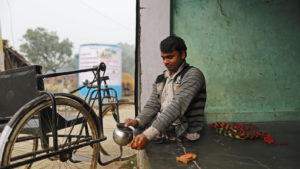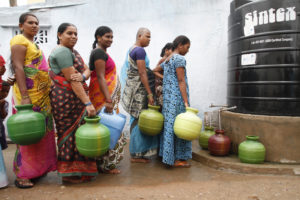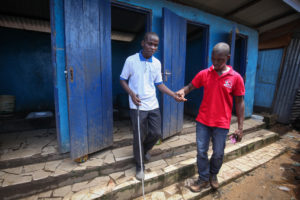Putting equality, inclusion and rights at the centre of a COVID-19 water, sanitation and hygiene response
April 2, 2020
This article was originally posted on WaterAid’s WASH Matters blog.
The poorest and least powerful sections of all societies are likely to be worst affected in crises, but we can work to alleviate inequalities through our response. Priya Nath and Louisa Gosling highlight how our emergency response to the coronavirus pandemic can mitigate new and existing vulnerabilities among people affected.
Handwashing with soap is the first line of defence in tackling the COVID-19 pandemic. Yet inequalities abound in access to water, sanitation and hygiene (WASH), services, and following the advice to wash your hands with soap regularly is not as easy for some as it may sound.
Years of experience and evidence show that income, economic context and landlessness; age, disability and health status; geographical location; and ethnicity, race, religion and gender all play huge roles in determining whether individuals, households and communities have appropriate, available, affordable and accessible WASH. At WaterAid, we have committed to tackling inequalities in all aspects of WASH access.
The way we approach the current extraordinary global health crisis can be no different. Tackling new and existing inequalities must be central to our emergency response to coronavirus. During the global COVID-19 pandemic, life-saving clean water for hygiene, safe sanitation and basic healthcare is more critical than ever. And delivering equitable, empowering WASH responses for all is fundamental.
In our support of COVID-19 responses through WASH we are both drawing on what we already know and learning new ways to reach the most marginalised and the most burdened.
What we already know about tackling inequalities in WASH and emergency contexts
1. Gender inequality is exacerbated in health emergencies and economic crises, so must be tackled in all response efforts
As schools close and families head into lockdown, domestic chores and caring responsibilities increase greatly. At the same time, increased calls for washing hands, as well as for cleaning and sanitising, multiply the need for water. Because of gender divisions of labour, it is women and girls who will have to collect this extra water, perform more labour and do more caring for people who become sick.
For the 29% of people who do not have water inside their home, the additional long journeys to water sources caused by increased demand for water will mean more chances of contact with others at waterpoints or kiosks. And for many it will mean spending more of their already scarce resources on buying water at an unaffordable cost.
Meanwhile, an estimated 70% of the global health and social care workforce are women. As the coronavirus pandemic spreads, these frontline workers face increased pressure and exposure to the virus, often with little personal protective equipment. This in the context of two out of every five healthcare facilities globally lacking handwashing facilities, and 55% in least developed countries lacking basic water supplies.
Health crises also increase risks of violence and harassment of frontline health workers, particularly women nurses. Amid the Ebola outbreak in the Democratic Republic of Congo, for example, the World Health Organization documented attacks on more than 300 healthcare facilities in 2019, leaving six workers and patients dead and 70 wounded.
During times of enforced isolation and closure of many public facilities, women and girls’ ability to manage menstruation can be compromised in communities and households. Finding a clean and private space to change and wash while remaining indoors for much of the time with their family, and accessing menstrual materials and water, can be difficult.
Finally, isolation measures, the inability to access previous social support systems and increases in financial and other stresses are increasing the risks of violence against women everywhere (download report PDF). Although not directly connected to WASH, this has implications for women’s ability to access essential services, and must be factored into our response, to ensure people’s safety and security when accessing WASH and other services.
You can read more about the gendered impacts of the COVID-19 pandemic in this article published in The Lancet.
2. Marginalised people become even more vulnerable during a crisis
People with chronic health issues, such as HIV, or other health conditions are dealing with increased fear of acquiring COVID-19, while often already experiencing social stigma and exclusion based on their health status. In an environment where misconceptions around HIV transmission or general discrimination might already prevent them from using communal WASH facilities, crises have the potential to exacerbate the situation, making handwashing and maintaining treatments even harder. Additionally they face the real risk of disruption to essential life-saving services, and concerns over whether they will be able to access treatment for COVID-19 on an equal basis to others.
More than a billion people globally live with disabilities, the rates higher in low-income countries and among those living in poverty or belonging to ethnic minorities. Once again, the health and social inequalities they already face are intensified in crises. For someone with a physical impairment, accessing clean water frequently can be a challenge because of distance, inaccessible infrastructure or reliance on others.
People with disabilities are often already isolated from the outside world, missing out on public health campaigns geared towards people who move around. And public health and information campaigns are rarely targeted to their specific requirements. Those who rely on a carer to help them with daily tasks face either the risk of added exposure to the virus through their carer, or an inability to get the help they need more than ever in challenging times.
Equally, public health messaging and calls to stay inside are hard to follow for people who have little or no access to WASH facilities; those who rely on daily wages to survive; those living in densely populated informal settlements or refugee camps; and street dwellers. This puts them at greater risk of not only COVID-19, but also harsh punishment by authorities. For example, we are already seeing a response that includes clearance of informal markets and housing in the name of ‘sanitisation’ in some places. The Ebola crisis in Monrovia in 2014 set a precedent for quarantining entire informal settlements that were deemed a ‘health risk’. This a deep injustice.
Our response efforts can mitigate both existing and new vulnerabilities
While the poorest and least powerful are likely to be worst affected in crisis situations, we can work to alleviate the inequality through our response:
- Support governments and other WASH actors to deliver the human right to water and sanitation as a central part of response efforts, provided in a way that is non-discriminatory and accessible to all.
- Develop crisis responses alongside the affected communitiesrather than for them, to ensure solutions meet cultural, social and religious challenges. Disability rights, women’s rights and indigenous rights groups, to name a few, are best placed to help us shape our response in a way that is empowering, does no harm and responds to real requirements.
- Tackle and confront any discrimination and stigmatisation in response efforts, related to factors such as age, gender, race, ethnicity, socio-economic status, livelihood type and caste. We must closely monitor our messaging, images and approaches to ensure they are not inadvertently fuelling discrimination.
- Promote collection of water, cleanliness of water and sanitation facilities and practising of hygiene as the responsibility of all – not just women.
- Recognise the obligations and responsibility of government and sector actors to respond; do not make this an issue of individual action or responsibility.
- Ensure we are collecting and disaggregating data to understand differing impacts on all parts of the population. At minimum age, disability, gender and location disaggregation is needed.
Read UNICEF’s COVID-19 Considerations for Children and Adults with Disabilities (PDF) guide.
Our simple list of dos and don’ts
As initial responses, including ours, rely heavily on visual and mass media public communications, it is vital that these are respectful and do no harm. Our list of actions to take and avoid can help.
Do: Use images and messaging that show responsibility for hygiene behaviours can be equally distributed.
- Ensure images are gender balanced.
- Include males in images of household & community hygiene practices to show collective responsibility.
Don’t
- Do not reinforce gender or other stereotypes – i.e. do not show only women doing washing, cleaning or looking after children.
Do: Frame messaging that builds community spirit, support and collective action.
- Use terms like ‘us’, ’we, ‘together as a community’, ‘altogether we can, etc.
- Use images that show people helping each other.
- Demonstrate sector/government response and duties, not just individual responsibility.
Don’t
- Do not focus only on individualistic messages, which reinforce individualistic responses and actions.
- Do not use emotional triggers such as shame, guilt or fear – we have a responsibility to avoid promoting further hysteria or blame.
- Avoid emotional or negative language.
Do: Portray people in all their diversity.
- Communities are made up of women, men, children, people with impairments, people of different ethnic or religious identifies, etc – reflect this reality in your communications to improve uptake.
Don’t
- Do not blame or associate individual factors such as gender, ethnicity, religion, age, impairment, health or poverty status with reasons for infection or contagion.
- Avoid messaging, images or implementation approaches that unintentionally stigmatise, ostracise or cause abuse for certain people.
Do: Acknowledge and respond to the diverse needs of communities.
- Demonstrate how assistive devices can be used.
- Demonstrate solutions that are relevant in low-income settlements, in rural and water scarce areas.
- The Compendium of accessible WASH technologies has illustrations and descriptions you can adapt.
Don’t
- Avoid blanket approaches that suggest that everyone can change behaviours without any specific adaptations.
- Do not direct messaging or responsibility for ‘change of behaviour’ at one group of people, e.g. mothers, instead talk about parents caring for children.
- Do not misrepresent the number of people who have a clean water supply or access to soap.
Do: Adapt communications to suit different target groups.
- Consider the communication and learning abilities of all people, including people with visual, hearing and intellectual impairments.
- Plan channels for information to reach all, especially those doing caring duties, sanitation work, etc.
- Takeaway materials can reinforce messages and make up for some short-term memory loss among older people or people with disabilities.
- These should be easy to read, large script, high contrast between text and paper, on non-glare/glossy paper, in local languages/dialects, highly visual.
Don’t
- Do not exclude anyone. Not being inclusive of all can lead to fear, shame and blame.
- Do not portray informal settlements or slum areas as ‘vectors of disease’, or poorer areas of the city as being unable to keep clean. This reinforces stigma and increases the chance of a negative reaction. For example, there have already been cases of informal housing being cleared in the name of ‘sanitisation’. The solution lies in guaranteeing adequate and safe levels of service for all, rather than reinforcing stigma towards certain parts of the population.
Do: As part of our do no harm approach, do a risk assessment before and throughout communications campaigns
- Monitor backlash on social media, such as racist comments and immediately delete as needed.
- Check that it does not amplify or put blame on one group (or if audience is interpreting it that way).
- List who is likely to miss out on the communication because of language, ability, culture or gender, and come up with strategies for how they could be included.
Don’t
- Do not ostracise or promote ‘calling out’ of people or parts of the population. This may encourage vigilante tactics or backlash.
- Avoid terms such as ‘victim’, ‘infecting’ or ‘spreading to others’.
- Do not tolerate any racist, bigoted or blaming comments on social media and have a strategy for monitoring these.
Priya Nath is Equality, Inclusion and Rights Advisor and Louisa Gosling is Senior WASH Manager – Accountability and Rights, both at WaterAid UK.


